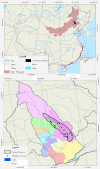Wild plant folk nomenclature of the Mongol herdsmen in the Arhorchin National Nature Reserve, Inner Mongolia, PR China
- PMID: 23628479
- PMCID: PMC3649933
- DOI: 10.1186/1746-4269-9-30
Wild plant folk nomenclature of the Mongol herdsmen in the Arhorchin National Nature Reserve, Inner Mongolia, PR China
Abstract
Background: Folk names of plants are the root of traditional plant biodiversity knowledge. In pace with social change and economic development, Mongolian knowledge concerning plant diversity is gradually vanishing. Collection and analysis of Mongolian folk names of plants is extremely important. During 2008 to 2012, the authors have been to the Arhorchin National Nature Reserve area 5 times. Fieldwork was done in 13 villages, with 56 local Mongol herdsmen being interviewed. This report documents plant folk names, analyzes the relationship between folk names and scientific names, looks at the structure and special characteristics of folk names, plant use information, and comparative analysis were also improved.
Methods: Ethnobotanical interviewing methods of free-listing and open-ended questionnaires were used. Ethnobotanical interview and voucher specimen collection were carried out in two ways as local plant specimens were collected beforehand and then used in interviews, and local Mongol herdsmen were invited to the field and interviewed while collecting voucher specimens. Mongolian oral language was used as the working language and findings were originally recorded in Mongolian written language. Scientific names of plants are defined through collection and identification of voucher specimens by the methods of plant taxonomy.
Results: A total of 146 folk names of local plants are recorded. Plant folk names corresponded with 111 species, 1 subspecies, 7 varieties, 1 form, which belong to 42 families and 88 genera. The correspondence between plant folk names and scientific names may be classified as one to one correspondence, two or three to one correspondence, and one to multitude correspondence. The structure of folk names were classified as primary names, secondary names and borrowed names. There were 12 folk names that contain animal names and they have correspondence with 15 species. There are nine folk names that contain usage information and they have correspondence with 10 species in which five species and one variety of plant are still used by the local people. The results of comparative analysis on the Mongol herdsmen in the Arhorchin National Nature Reserve and the Mongolians in the Ejina desert area shows that there are some similarities, as well as many differences whether in language or in the structure.
Conclusion: In the corresponding rate between plant folk names and scientific names yielded a computational correspondence of 82.19%, which can be considered as a high level of consistency between scientific knowledge and traditional knowledge in botanical nomenclature. Primary names have most cultural significance in the plant folk names. Special characteristic of plant folk names were focused on the physical characteristics of animals which were closely related to their traditional animal husbandry and environment. Plant folk names are not only a code to distinguish between different plant species, but also a kind of culture rich in a deep knowledge concerning nature. The results of comparative analysis shows that Mongolian culture in terms of plant nomenclature have characteristics of diversity between the different regions and different tribes.
Similar articles
-
A historical and ethnobotanical study on local botanical knowledge recorded in the book "Mongolia and Amdo and the Dead City of Khara-Khoto".J Ethnobiol Ethnomed. 2021 May 25;17(1):36. doi: 10.1186/s13002-021-00443-2. J Ethnobiol Ethnomed. 2021. PMID: 34034764 Free PMC article.
-
Medicinal wild plants used by the Mongol herdsmen in Bairin Area of Inner Mongolia and its comparative study between TMM and TCM.J Ethnobiol Ethnomed. 2019 Jul 3;15(1):32. doi: 10.1186/s13002-019-0300-9. J Ethnobiol Ethnomed. 2019. PMID: 31269968 Free PMC article.
-
Indigenous knowledge for plant species diversity: a case study of wild plants' folk names used by the Mongolians in Ejina desert area, Inner Mongolia, P. R. China.J Ethnobiol Ethnomed. 2008 Jan 16;4:2. doi: 10.1186/1746-4269-4-2. J Ethnobiol Ethnomed. 2008. PMID: 18199323 Free PMC article.
-
Ethnobotanical profiles of wild edible plants recorded from Mongolia by Yunatov during 1940-1951.Hist Philos Life Sci. 2021 Aug 11;43(3):100. doi: 10.1007/s40656-021-00428-0. Hist Philos Life Sci. 2021. PMID: 34382157 Free PMC article. Review.
-
An overview on ethnobotanico-pharmacological studies carried out in Morocco, from 1991 to 2015: Systematic review (part 1).J Ethnopharmacol. 2021 Mar 1;267:113200. doi: 10.1016/j.jep.2020.113200. Epub 2020 Aug 1. J Ethnopharmacol. 2021. PMID: 32750461
Cited by
-
"A herder's duty is to think": landscape partitioning and folk habitats of Mongolian herders in a mountain forest steppe (Khuvsugul-Murun region).J Ethnobiol Ethnomed. 2019 Nov 20;15(1):54. doi: 10.1186/s13002-019-0328-x. J Ethnobiol Ethnomed. 2019. PMID: 31747913 Free PMC article.
-
A study of the plant folk nomenclature of the Yi people in Xiaoliangshan, Yunnan Province, China, and the implications for protecting biodiversity.J Ethnobiol Ethnomed. 2022 Mar 15;18(1):18. doi: 10.1186/s13002-022-00504-0. J Ethnobiol Ethnomed. 2022. PMID: 35292043 Free PMC article.
-
From the name to the popular image of the plant: the Polish names for the black elder (Sambucus nigra).J Ethnobiol Ethnomed. 2024 Jan 30;20(1):12. doi: 10.1186/s13002-024-00649-0. J Ethnobiol Ethnomed. 2024. PMID: 38291469 Free PMC article.
-
Wild edible plants collected and consumed by the locals in Daqinggou, Inner Mongolia, China.J Ethnobiol Ethnomed. 2020 Oct 9;16(1):60. doi: 10.1186/s13002-020-00411-2. J Ethnobiol Ethnomed. 2020. PMID: 33036666 Free PMC article.
-
A historical and ethnobotanical study on local botanical knowledge recorded in the book "Mongolia and Amdo and the Dead City of Khara-Khoto".J Ethnobiol Ethnomed. 2021 May 25;17(1):36. doi: 10.1186/s13002-021-00443-2. J Ethnobiol Ethnomed. 2021. PMID: 34034764 Free PMC article.
References
-
- Text of the CBD. http://www.cbd.int/convention/articles/?a=cbd-08.
-
- Text of the Convention for the Safeguarding of Intangible Cultural Heritage. http://www.unesco.org/culture/ich/index.php?lg=en&pg=00006.
-
- Berlin B. Ethnobiological Classification: Principles of Categorization of Plant and Animals in Traditional Societies. New Jersey: Princeton University Press; 1992.
-
- Berlin B. Folk systematics in relation to biological classification and nomenclature. Annu Rev Ecol Systemat. 1973;4:71–295.
Publication types
MeSH terms
LinkOut - more resources
Full Text Sources
Other Literature Sources
Medical
Research Materials


